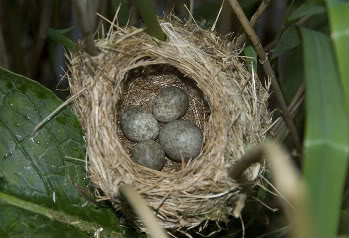|
|
The cuckoo bird is famous for its parental strategy: rather than raise its own children it infiltrates the nest of an unsuspecting bird of a different species, replacing that bird’s eggs with its own; when the cuckoo babies are born the ‘adoptive’ parents end up unwittingly rearing young that is not theirs. However, at least one bird species—the reed wabler—has learned to defend itself against such clever incursions.
Scientists describe the relationship between the cuckoo and the reed wabler as an ‘arms race’: when once one species establishes a new defense, the other begins a new strategy. In a new study published in Science reseachers have discovered a new weapon employed by the reed wablers in the arms race with cuckoos: social learning.
 Reed wabler nest parasitized by common cuckoo, larger eggs is the parasitic egg. Image courtesy of Science and AAAS. |
“Studies of co-evolutionary arms races between brood parasites and hosts have emphasised genetic adaptations and counter adaptations; however, our field experiments show that transmission through social learning provides a mechanism by which hosts can adjust their nest defence and so respond rapidly to changes in parasitism,” said Dr. Justin Welbergen.
Scientists at the University of Cambridge discovered that reed wablers will attack in unison cuckoos when they enter the wablers’ territory. This behavior is taught byway of inexperienced wablers observing their fellows. There are risks with such attacks, however, since such attacks can lead to injuries with the wablers and, in the ruckus, expose them to predators.
In order to test the reed wabler’s willingness (or foolhardiness) to put their selves in danger, scientists from the University of Cambridge sent non-cuckoo species, such as parrots, into the reed wablers territory to see what would happen. The answer: nothing. This suggested that reed wablers have used social learning in their defensive behavior, so that they only attack when confronted with a true threat, like the cuckoo.
“Our previous work showed that reed warblers distinguish cuckoos from other nest enemies and adjust their defences according to local parasitism risk,” says Welbergen. “Our current work demonstrates that reed warblers can use social information to fine-tune their defences to the nature of the local threat.”
Related articles
Rooks use tools in captivity rivaling ‘habitual tools users such as chimpanzees’
(05/26/2009) The rook, a member of the crow family, is the most recent bird to prove the ability to use tools, a capacity once thought to belong only to humans. Although rooks have never been observed using tools in the wild, researchers were astounded at how quickly—sometimes during the first try—rooks were able to employ tools to attain food.
Birds can dance, proving humans aren’t the only ones with rhythm
(04/30/2009) Another ability long-thought to belong solely to humans, like tool-use or counting, does in fact occur in other species, according to two new studies. In this case, it is the capacity to move rhythmically with music. Studying two different birds the research groups found that the birds weren’t just moving randomly or mimicking owners, but actually changing the tempo of their movement to match the music—in other words, dancing.
Stop staring at me: birds react to human gaze
(04/06/2009) A new study of jackdaws shows that these crow-like birds react to humans watching them, changing their behavior depending on who is looking and how the gaze moves.